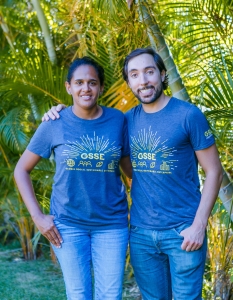July 13, 2019 – This blog post is written by Kelsey Baun and Erica Malchodi – two students in the Global Social and Sustainable Enterprise MBA who have spent their summer conducting their practicum research in Puerto Rico.

Erica and Kelsey in Puerto Rico
In September of 2017, Puerto Rico was slammed by Hurricane Maria. Three months later, residents were still without power, and few had access to clean water. The storm initiated a difficult time for Puerto Rico –they are currently experiencing a crippling economic crisis, high unemployment, and a fleeing population.
How does a community stabilize and revitalize its economy following this level of devastation? What needs have not yet been met? And — perhaps most importantly — what can people outside Puerto Rico do to help these communities bounce back?
Now, 21 months later, these questions brought us to this picturesque island to conduct our summer research.
Immediately following Maria, there was an outpouring of relief efforts. But once resources were disbursed and basic needs (presumably) met, long-term relief must begin. This takes economic and community revitalization. From our research over the past nine months, we believe tourism has a role to play in this revitalization. People increasingly want to travel with purpose – to make a mark on communities in need that are also desirable destinations. Through authentic collaboration with the community and shared service-focused experiences, economies can be rebuilt with the support of purposeful travel.
Here in Puerto Rico, we’ve witnessed a resilient community including local organizations doing incredible work toward long-term recovery. We’ve had the privilege of working alongside organizations, such as Para la Naturaleza, Global Works, Discover Puerto Rico, and World Central Kitchen.
- From Para La Naturaleza we learned about how that organization is working to maintain Puerto Rico’s natural resources for future generations. By utilizing volunteers – for post-recovery reforestation, preservation efforts at plant nurseries, beach cleanup, and environmental ecosystems data collection, Para is creating opportunities for locals and visitors to become a part of the solution.
- With Global Works we see the positive impact of collaboration between volunteers and locals as a method to assist destinations post-recovery. We volunteered alongside community members, rebuilding homes in the region of Vega Alta. The relationships between the community leaders and the volunteers are inspiring. By listening to the needs of the community, Global Works is providing groups of students with collaborative and insightful volunteer experiences, while helping to rebuild and create a safe space for the local families to live.
- Discover Puerto Rico, the island’s destination marketing office, is working tirelessly to expand the visitor economy to all seven regions of the island. With this goal in mind, Discover Puerto Rico has provided free digital marketing workshops to over 200 local business owners, teaching them use its website as a tool to attract new business.
- And World Central Kitchen is offering a two-tiered initiative. Tier one, an emergency-response phase, focused on feeding those in need by using local ingredients and chefs. The second tier, long-term recovery, varies by destination. In Puerto Rico the program is called Plow to Plates, providing grants and business support to small shareholder farms. Currently, 85% of the island’s food is imported; WCK believes there must be a commitment to growing and distributing local food to help Puerto Rico be more self-sustaining. WCK is embracing the agritourism trend to utilize volunteers to support the farmers and raise awareness.
To be continued.

Kelsey and Erica delivering a presentation to one of their partner organizations in Puerto Rico




















